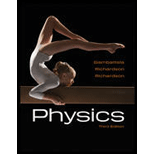
Concept explainers
(a)
The object distance.
(a)
Answer to Problem 79P
The object distance is
Explanation of Solution
Write the transverse magnification equation in terms of the object and image heights.
Here,
Write the transverse magnification equation in terms of the object and image distances.
Here,
Equate equations (I) and (II) and rewrite the equation for
Conclusion:
Given that the height of the object is
Substitute
Therefore, the object distance is
(b)
The type of the mirror used.
(b)
Answer to Problem 79P
The mirror is convex.
Explanation of Solution
The images formed by a plane mirror are upright and virtual and for point objects, the object and the image are equidistant from the mirror and lie on the same normal line. Depending on the location of the object, a concave mirror can form either real or virtual images and the images can be larger or smaller than the object. The images formed by a convex mirror are upright, virtual, smaller than the object and closer to the mirror than the object.
In part (a), it is found that the image is smaller in height than the object and it is given that the image is virtual. Also the image is upright and closer to the mirror than the object. This implies the used mirror is convex.
(c)
The focal length and the radius of curvature of the mirror.
(c)
Answer to Problem 79P
The focal length of the mirror is
Explanation of Solution
Write the mirror equation.
Here,
Rewrite the above equation for
Put equation (III) in the above equation.
Write the equation for the radius of curvature .
Here,
Conclusion:
Substitute
Substitute
Therefore, the focal length of the mirror is
Want to see more full solutions like this?
Chapter 23 Solutions
Physics
- Part A: kg (a) Water at 20 °C (p = 998.3 and v = 1 × 10-6 m²/s) flows through a galvanised m³ iron pipe (k = 0.15 mm) with a diameter of 25 mm, entering the room at point A and discharging at point C from the fully opened gate valve B at a volumetric flow rate of 0.003 m³/s. Determine the required pressure at A, considering all the losses that occur in the system described in Figure Q1. Loss coefficients for pipe fittings have been provided in Table 1. [25 marks] (b) Due to corrosion within the pipe, the average flow velocity at C is observed to be V2 m/s after 10 years of operation whilst the pressure at A remains the same as determined in (a). Determine the average annual rate of growth of k within the pipe. [15 marks] 4₁ Figure Q1. Pipe system Page 2 25 mmarrow_forwardFor an independent study project, you design an experiment to measure the speed of light. You propose to bounce laser light off a mirror that is 53.5 km due east and have it detected by a light sensor that is 119 m due south of the laser. The first problem is to orient the mirror so that the laser light reflects off the mirror and into the light sensor. (a) Determine the angle that the normal to the mirror should make with respect to due west.(b) Since you can read your protractor only so accurately, the mirror is slightly misaligned and the actual angle between the normal to the mirror and due west exceeds the desired amount by 0.003°. Determine how far south you need to move the light sensor in order to detect the reflected laser light.arrow_forwardA mirror hangs 1.67 m above the floor on a vertical wall. A ray of sunlight, reflected off the mirror, forms a spot on the floor 1.41 m from the wall. Later in the day, the spot has moved to a point 2.50 m from the wall. (a) What is the change in the angle of elevation of the Sun, between the two observations?arrow_forward
- It is not (theta 1i) or (pi/2 - theta 2i)arrow_forwardAssume the helium-neon lasers commonly used in student physics laboratories have power outputs of 0.250 mW. (a) If such a laser beam is projected onto a circular spot 3.40 mm in diameter, what is its intensity (in watts per meter squared)? 27.5 W/m² (b) Find the peak magnetic field strength (in teslas). 8.57e-7 X T (c) Find the peak electric field strength (in volts per meter). 144 V/marrow_forwardIdentify the most likely substancearrow_forward
 College PhysicsPhysicsISBN:9781305952300Author:Raymond A. Serway, Chris VuillePublisher:Cengage Learning
College PhysicsPhysicsISBN:9781305952300Author:Raymond A. Serway, Chris VuillePublisher:Cengage Learning University Physics (14th Edition)PhysicsISBN:9780133969290Author:Hugh D. Young, Roger A. FreedmanPublisher:PEARSON
University Physics (14th Edition)PhysicsISBN:9780133969290Author:Hugh D. Young, Roger A. FreedmanPublisher:PEARSON Introduction To Quantum MechanicsPhysicsISBN:9781107189638Author:Griffiths, David J., Schroeter, Darrell F.Publisher:Cambridge University Press
Introduction To Quantum MechanicsPhysicsISBN:9781107189638Author:Griffiths, David J., Schroeter, Darrell F.Publisher:Cambridge University Press Physics for Scientists and EngineersPhysicsISBN:9781337553278Author:Raymond A. Serway, John W. JewettPublisher:Cengage Learning
Physics for Scientists and EngineersPhysicsISBN:9781337553278Author:Raymond A. Serway, John W. JewettPublisher:Cengage Learning Lecture- Tutorials for Introductory AstronomyPhysicsISBN:9780321820464Author:Edward E. Prather, Tim P. Slater, Jeff P. Adams, Gina BrissendenPublisher:Addison-Wesley
Lecture- Tutorials for Introductory AstronomyPhysicsISBN:9780321820464Author:Edward E. Prather, Tim P. Slater, Jeff P. Adams, Gina BrissendenPublisher:Addison-Wesley College Physics: A Strategic Approach (4th Editio...PhysicsISBN:9780134609034Author:Randall D. Knight (Professor Emeritus), Brian Jones, Stuart FieldPublisher:PEARSON
College Physics: A Strategic Approach (4th Editio...PhysicsISBN:9780134609034Author:Randall D. Knight (Professor Emeritus), Brian Jones, Stuart FieldPublisher:PEARSON





